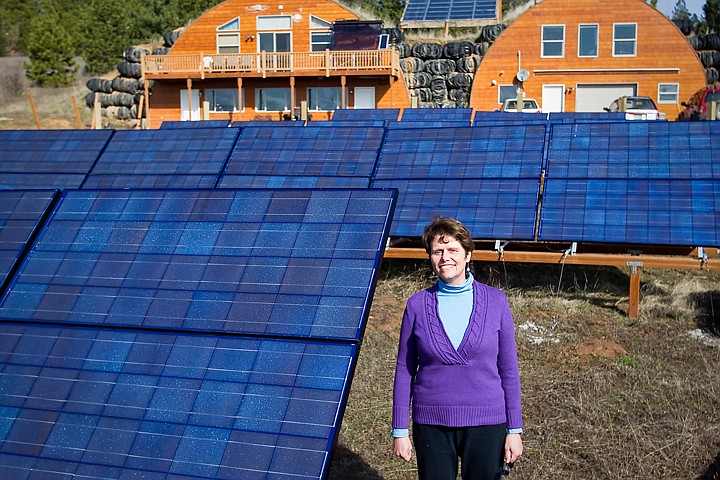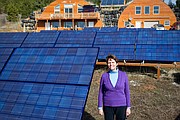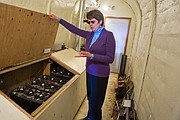Down-to-earth living
Jena Pittmon stands on a high, grassy mound, peering out across the land where she lives and works. Below the turf and dirt under her feet is her living room.
Jena Pittmon stands on a high, grassy mound, peering out across the land where she lives and works.
Below the turf and dirt under her feet is her living room.
Pittmon’s home is a pair of domes connected by a tunnel. Covered almost completely by earth, the structure is tucked among the sloping, rolling hills south of Coeur d’Alene.
“The reason that we’re here and that we like earth-sheltered homes is that they use way less energy than most homes,” Pittmon said.
No poles or power lines obstruct the view from the earth-sheltered residence.
The home is completely off-grid, powered by energy harnessed from the sun and the wind.
A bank of solar panels lines the incline that leads to her front door. A wind turbine spins in the breeze from the top of a pole near the base of the home’s driveway.
Because the residence is mainly underground, it benefits from the constant temperature of the earth.
“When you’re covered with dirt, you never have a temperature that’s outside the building that’s less than or more than about 55 degrees,” Pittmon said. “In the winter we could actually walk away from this house, with no heating on for the entire winter, and the temperature would never get below 55 degrees. We would never have a problem with pipes freezing.”
With partners Lee Pittmon and Albert Lassiter, Pittmon purchased the 10-acre property and began constructing the living space five years ago with Lee as contractor.
They’ve lived in the 4,000-square-foot, rounded structure for three years.
“It was pretty interesting building it. When we had it covered with dirt, there was a bulldozer on top of our house,” Pittmon said.
The domes’ walls are filled with rebar and concrete with earth backfilled over all but one side. The dirt is reinforced with about 370 tire bales that contain 100 tires each.
“There are about 37,000 tires around our house, so we’ve put carbon back into the ground,” Pittmon said.
They have a solar-powered water pump and a 3,000-gallon holding tank.
Inside the dome comprising the main living area, things don’t look much different than inside a traditional home, with an open living room and kitchen, and three bedrooms.
In the dome’s furthest recesses, away from the structure’s windowed front walls and sunlight, there is an entertainment room and exercise room.
The tunnel leads from the kitchen into the second dome where there is a utility room, shop area, and the residence’s energy system with a 48-volt bank of batteries that store the generated energy. The house is heated by a solar and wind-powered hydronic system.
On the upper level of the second dome, upstairs from the shop, is a music studio and office.
This is where Pittmon runs her Web site development business, Open Ears Web Design. The green company is powered solely by home-generated energy.
They also have an annualized geothermal solar panel that captures heat and directs it into the dirt under the home where it is stored until it rises in the winter to provide radiant heating.
Most of the energy used in the home comes from the traditional solar panels and wind turbines. When the sun isn’t shining and there’s no wind, they have a propane-powered generator to fill the gap.
“In the summertime, when we have sunny days, by 8 a.m. our batteries will be full,” Pittmon said. “Then we have all this power-generating capability and it’s just sitting there.”
She sometimes wishes they were hooked into the grid because they could be generating power for the utility company.
Before moving into the earth-sheltered home, Pittmon lived in Post Falls where they had a wind generator that fed surplus energy back into the grid.
They’re not hooking in now because they don’t need to buy it. Plus, it would cost about $30,000 to run the lines and connect with power about a quarter-mile away.
They pay close attention and restrict their usage because they try to use what they generate, she said.
“A lot of people don’t think about it because the cost of energy is pretty inexpensive,” Pittmon said. “I read somewhere that the average family uses about 30 kilowatts a day, and we use 10, so people just need to learn how to use less energy.”
If people have questions about earth-sheltered homes or living off-grid, she suggests they contact her through her Web site, www.openearsweb.com.





